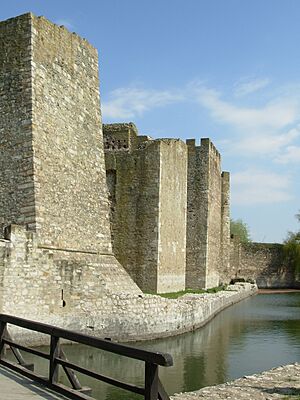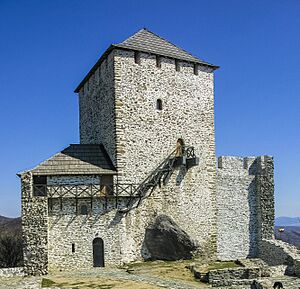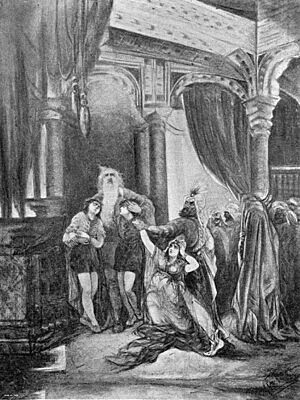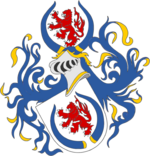Đurađ Branković facts for kids
Quick facts for kids Đurađ Branković |
|
|---|---|
| Despot of the Kingdom of Rascia | |
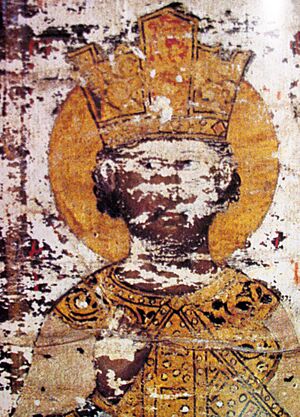
Portrait from The Esphigmen Charter of despot Đurađ Branković, issued to the monastery of Esphigmen on Athos in 1429
|
|
| Lord of Branković domain | |
| Reign | 1396–1412 |
| Predecessor | Vuk Branković |
| Despot of Serbia | |
| Reign | 1427–1456 |
| Predecessor | Stefan Lazarević |
| Successor | Lazar Branković |
| Born | 1377 |
| Died | 24 December 1456 (aged 78–79) |
| Spouse | Eleni of Trebizond disputed Eirene Kantakouzene |
| Issue | Todor Branković Grgur Branković Mara Branković Stefan Branković Katarina, Countess of Celje Lazar Branković |
| House | Branković |
| Father | Vuk Branković |
| Mother | Mara Lazarević |
Đurađ Branković (Serbian Cyrillic: Ђурађ Вуковић Бранковић; born 1377, died 1456) was an important Serbian ruler. He was known as the Serbian Despot from 1427 to 1456. He was one of the last medieval rulers of Serbia. During his time, Serbia was a vassal state, meaning it had to obey both the Ottoman sultans and the Hungarian kings.
Đurađ stayed neutral during big wars in 1444 and 1448. In 1455, he was hurt and captured in a fight with the Hungarians. After this, the young Sultan Mehmed II started a big attack on Belgrade. Đurađ died at the end of 1456 because of his old wound. After his death, Serbia and other nearby lands were taken over by Sultan Mehmed II.
Đurađ had a large collection of books and writings. He made his capital city, Smederevo, a center for Serbian culture. He was the first ruler from the Branković dynasty to lead Serbia.
Contents
Early Life and Family
Đurađ was the son of Lord Vuk Branković and Mara Lazarević. His mother, Mara, was the daughter of Prince Lazar Hrebeljanović. Đurađ's wife was Eirene Kantakouzene. She was a Byzantine princess. Her brother, Thomas Kantakouzenos, was a commander in Smederevo.
Despot Stefan Lazarević was Đurađ's cousin. Stefan had no children. He chose Đurađ to be his heir, or the next ruler. So, when Đurađ became the Despot in 1427, he was 50 years old. He had a lot of experience in ruling.
Ruling Serbia
Becoming Despot
When Despot Stefan died, Đurađ was in Zeta (modern-day Montenegro). The Hungarian King Sigismund was in Wallachia. Both rushed to Belgrade Fortress. They had talks about Belgrade in late 1427. King Sigismund said he would recognize Đurađ as the new Serbian ruler. But only if Đurađ gave Belgrade to Hungary.
The Serbian leaders, including Đurađ, agreed to give Belgrade to the Hungarians. King Sigismund wanted Belgrade and Golubac to be part of Hungary's defenses. But a Serbian duke named Jeremiah refused to accept Đurađ as the new ruler. Jeremiah gave the city of Golubac to the Ottomans instead. This was a big problem for King Sigismund.
In 1428, King Sigismund tried to take Golubac back. But Sultan Murad II arrived with his army and defeated King Sigismund. After this, Đurađ Branković and the Duke of Wallachia agreed to pay tribute to the Sultan. This meant they had to pay money to the Ottoman Empire.
Building a New Capital
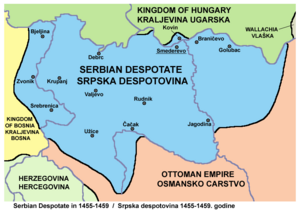
Since Hungary took Belgrade and the Ottomans took Golubac, Đurađ needed a new capital. He decided to build a new fortress city called Smederevo. It was built on the Danube River. Smederevo was placed between Hungarian Belgrade and Ottoman Golubac.
Building Smederevo took a lot of effort and resources. From 1428 to 1430, a small town was built. This included the Despot's court. Then, a larger town was built around it. This bigger town protected the people living there. It had houses, churches, shops, and places for people to hide. Greek builders led the construction.
In 1429, the Byzantine Emperor sent a person to crown Đurađ. He was crowned as the Despot of Rascia, which was another name for Serbia.
Family Alliances and Ottoman Pressure
On April 20, 1434, Đurađ Branković's youngest daughter, Katarina, married Ulrich II of Celje. This marriage showed good relations with Hungary. But it also worried the Ottomans. The Sultan's advisor came to Smederevo. He said that Serbia would only be safe if Đurađ's older daughter married Sultan Murad II.
After much thought, Đurađ agreed. His daughter, Mara Branković, became engaged to the Sultan. That autumn, Murad sent his important advisors to get his future wife. Đurađ was in a difficult spot. The Hungarian king thought he was on the Ottoman side. The Sultan thought he was on the Hungarian side.
In August 1435, Serbia and the Republic of Venice signed a friendship agreement in Smederevo.
Sultan Murad II heard that Christian leaders in Europe were planning a big war against the Ottomans. He thought Đurađ would join them. So, Murad II decided to attack Serbia first. In 1439, the Sultan's army attacked Smederevo. They wanted to capture the new capital.
After three months, in August 1439, Smederevo fell. The defenders, led by Đurađ's son Grgur, ran out of food. They opened the city gates to prevent a massacre. Sultan Murad II gave Grgur a small piece of land. But later, he sent Grgur to his sister Mara in Edirne. Mara, the Sultan's wife, became an important person who supported the Ottomans in the Balkans.
Exile and Return
After Serbia fell, Đurađ went to Hungary. He stayed with the Hungarian King Albert II of Germany. The news of Serbia falling to the Ottomans spread fear in Hungary. King Albert died soon after. His death led to a civil war in Hungary that lasted 20 years.
Đurađ tried to get his son Lazar to marry the Hungarian Queen Elizabeth. But this did not happen. Đurađ was upset that his family missed a chance for the Hungarian throne. He left Hungary.
The Ottoman Sultan continued to act. He sent an army into Serbia. They captured Niš and Kruševac. They also attacked Novo Brdo. King Sigismund sent his army to help Đurađ. They defeated a large Ottoman group.
Đurađ also tried to get Golubac back from Jeremiah. But Jeremiah refused. In 1428, a new Hungarian army attacked Golubac. King Sigismund himself led the army. But Sultan Murad also arrived. Sigismund did not want to fight the stronger Ottoman army. He quickly made peace. As the Hungarians left, the Ottomans attacked them from behind. During these fights, southern and eastern Serbia were badly damaged.
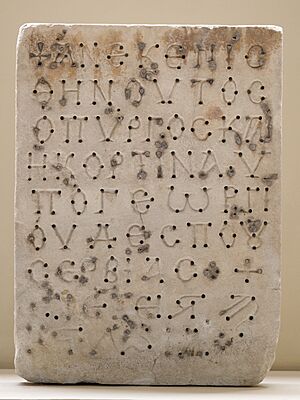
When the Ottomans captured Thessalonica in 1430, Đurađ paid money to free many of its citizens. But he still had to serve the Ottomans. He sent one of his sons to join the Ottoman army. They attacked Durazzo and Gjon Kastrioti.
Đurađ traveled from Hungary to Zeta (modern-day Montenegro). He went with his wife Eirene and some soldiers. He visited his daughter Katarina in Zagreb. Then he went to Dubrovnik. From there, he continued to his coastal towns of Budva and Bar. Bar became the new capital of the part of his land that was left. He tried to gather forces to take back Serbian land from the Ottomans.
In Zeta, some local leaders rebelled against Đurađ's governor. Đurađ left Zeta in April 1441. He stayed in Dubrovnik. The Ottomans wanted Dubrovnik to hand over Đurađ. But Dubrovnik refused. They said they were a free city and welcomed anyone seeking safety.
The Crusade of Varna
After some battles in 1443, Đurađ Branković helped make peace. This was the Peace of Szeged in 1444. It was between Hungary and the Ottomans. Sultan Murad II wanted peace too. He was married to Đurađ's daughter, Mara. Mara helped start the peace talks.
This peace deal gave Đurađ his Serbian rule back. But he had to pay a lot of money to John Hunyadi, a Hungarian leader. On August 22, 1444, Đurađ peacefully took back Smederevo.
Battle of Kosovo (1448)
The peace did not last long. Hunyadi and the Polish King broke it in the same year. This led to the Crusade of Varna. A Christian army led by John Hunyadi was defeated by Sultan Murad II's forces. This happened at Kosovo Polje in 1448. This was the last major attempt in the Middle Ages to push the Ottomans out of southeastern Europe.
After the battle, Đurađ Branković even captured Hunyadi for a short time. This was because of their personal disagreements.
Return and Death
In 1456, John Hunyadi won a victory against Mehmet II at the siege of Belgrade. After this, there was a time of peace. The Sultan went back to Adrianople. Đurađ got Serbia back.
But before the end of the year, Đurađ, who was 79 years old, died. Serbian independence lasted only three more years after his death. The Ottoman Empire then officially took over his lands. This happened because of disagreements among his wife and his three remaining sons.
About Đurađ
Đurađ was described as a "nice lord and large [in person]". People at the time thought he was the richest ruler in all of Europe. He earned a lot of money from the gold and silver mines in Novo Brdo. He also had lands in Hungary that brought him income.
Legacy
Đurađ Branković is listed in The 100 most prominent Serbs. This is a list by the Serbian Academy of Sciences and Arts. His character has also been shown in the Netflix show Rise of Empires: Ottoman.
Titles
Đurađ Branković had many titles during his rule. Some of them were:
- "Despot of the Kingdom of Rascia and Lord of Albania"
- "Despot of all of the Kingdoms of Rascia and Albania"
- "Despot and Duke of Rascia"
- "Lord of Rascia [and] Albania"
- "Lord, Despot of the Serbs"
- "Lord of the Serbs and Pomorije and Podunavije"
- "Despot, Lord of the Serbs and the Zetan Maritime"
- "Prince, Despot of the Kingdoms of Rascia and Albania"
Family and Children
Đurađ Branković had at least six children:
- Todor (died before 1429). He likely died young.
- Grgur (born around 1415, died 1459). He was blinded in 1441.
- Stefan (born around 1417, died 1476). He was also blinded in 1441. He later tried to rule Serbia.
- Katarina (born around 1418, died 1490). She married Ulrich II of Celje.
- Mara (born around 1420, died 1487). She married Murad II of the Ottoman Empire.
- Lazar (born around 1421, died 1458). He was the youngest son.
See also
- Arača
- Branković dynasty
- Serbian Despotate


